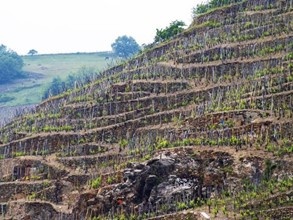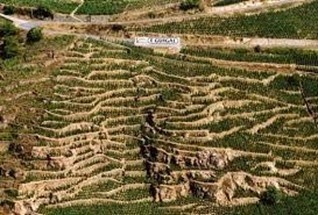THE MYSTERY AND MAGIC OF SYRAH
When I was learning about wine I didn’t give Syrah much thought. The grape variety wasn’t found in all the popular classic wine regions in the 1970s—Bordeaux, Burgundy, Chateauneuf-du-Pape, Champagne, Germany, Rioja, Barolo, Chianti Classico, Sherry or Porto. California didn’t have its first varietal Syrah until Joseph Phelps produced one in 1974, five years after the first vintage Merlot was produced in California by Sterling Vineyards.
(There was a moderately popular red wine called Petite Sirah, but I could write a whole article on the twisted story of that troubled variety, also known as Durif. Despite the similarity of the name there was only the most oblique relation to true Syrah.)
So what the hell was Syrah?
My wine books told me that Syrah was the red grape of France’s northern Rhone Valley, producing well-regarded wines one almost never came across, like Hermitage and Côte-Rôtie. These were the days before Robert Parker, Jr. championed Rhone wines in the 1980s and published a book on the subject in 1987. Suddenly wines from Hermitage and Côte-Rôtie, which were never made in large quantities, became sought-after rarities along with highly rated Syrahs from nearby Cornas, with slightly less enthusiastic recommendations for a few less expensive red wines from Saint-Joseph and Crozes-Hermitage, all made from Syrah. Guigal's famous "La-Las" (rare Cote Rotie bottlings called La Mouline, La Landonne and La Turque) led the pack of desirables with astronomic prices to match.
Drawing on this newfound popularity were American vintners who, after seeing the feverish demand for northern Rhone wines, planted Syrah in California’s North Coast (Napa, Sonoma, Mendocino), Central Coast, Sierra Foothills and Washington State, making many interesting, and sometimes compelling wines along the way. Syrah had also been a notable wine in Australia for hundreds of years, where it was known as Shiraz, and it became an affordable import in the 1980s, with more serious, expensive bottlings to follow.
The trouble with Syrah planted in so many places with so many different soils and climates, there was never a consensus among wine consumers about what Syrah should taste like—no benchmark, no reference point, no domestic north star, like Cabernet Sauvignon had in Oakville and Rutherford. Warm-climate Syrahs, like most from Paso Robles, were loosey-goosey globs in a glass with no structure and an overripe flatness in the taste and on the palate. They bore no resemblance to the liveliness of cooler climate Syrahs grown in Sonoma, Edna Valley, the Sierra Foothills (and later in the Sta. Rita Hills) or the salty plushness of Australian Barossa Shiraz. And they certainly didn’t perform like classic Hermitage, Côte-Rôtie and Cornas, statuesque wines created in the original locales of the variety capable of reaching heights only achieved by the finest wines in the world.
I certainly had no sense of what Syrah was all about. And I wasn't alone.
Despite the public’s general ambivalence toward Syrah, there are many champions of the variety making good wines from different terroirs, and they deserve more attention. That still begs the questions: what does good Syrah taste like? And my favorite question, what do you do with Syrah when you get it home, i.e., what foods should I serve with it, or is it better consumed by itself in a glass like you would drink a martini?
For me, the first question crystallized on one chilly January day in 1992, when for the first time I had a real epiphany with Syrah. Having been appointed the southern California distributor for Kermit Lynch Imports a mere six months earlier, my business partner and I were on our first importer tour of Kermit properties and we found ourselves at the northernmost part of Syrah country, Côte-Rôtie. Staring up at the steep, terraced vineyards, each vine grape-staked but naked in its dormant season, we visited and tasted wines at the now defunct Gentaz-Dervieux, followed by René Rostaing, Guy Bernard and finally Robert Jasmin where my Syrah switch finally turned on.


Robert put his glass thief into an ancient barrel and drew out a darkly colored wine he skillfully deposited in each of our glasses. I swirled mine and stuck my nose in the glass.
“My God!” I heard myself say. The aroma was something I had never experienced before: violets and blueberries intertwined into a perfume so captivating it stopped me in my tracks. Was there some perfumed Viognier blended into Jasmin’s darkly hued Syrah? It’s allowed in Cote Rotie, but not mandatory. In my mouth, the wine had a velvety texture, unlike Petite Sirah’s cut, structured, short one. It was as expressive as a great red Burgundy, with an impossibly exotic aroma and flavor all its own. This, I thought, is Syrah!
Some classic Syrahs evoke smoke, bacon and other meats, which in small doses can add intriguing complexity to the wines, but I gravitate more to the fruit and flower aromatics and taste.
It snowed that night in Côte-Rôtie. The Jasmin wine was made from grapes grown in a cool continental climate, which reinforced its aromatics, texture and structure. It was a world away from the Mediterranean-climate southern Rhone wines I’d discovered a few days earlier at Vieux-Telegraphe in Chateauneuf-du-Pape, Domaine du Cayron in Gigondas and Domaine de Sang de Cailloux in Vacqueyras, all of which contained Syrah, but only used as a supporting player to the star of the southern Rhone, Grenache.
That singular experience in Robert Jasmin's cellar was such a monumental moment, it imprinted on me everything I would seek out in any Syrah I encountered thereafter.
This was not a realistic expectation, of course. I rarely found those Cote-Rotie components in domestic Syrahs, even ones that included dollops of Viognier in their blends. It got close one time in a Blue Rock Syrah a couple decades ago, and once more in a Chad Melville Samsarra bottling from 2010. Some vintages of Verzier’s St. Joseph have given me some of that blueberry-violet character, but very few other Syrahs, even from Côte-Rôtie, have captured me the way Jasmin’s 1990 from barrel did. (A few year later Robert Jasmin died when a car ran into him walking along the side of a road, and I’ve been told that his successors now use new oak barrels and the old character has been lost.)
Pardon me, I just realized I haven’t answered part of the “what do I do with this wine when I get it home?” question. I reach for northern Rhone Syrah when I’m eating lamb—leg of lamb, rack of lamb—but not beef, for me, anyway.
So now we’re back to the question “What should Syrah taste like?” The answer, I'm afraid, is as ambiguous as the answer to “What should Pinot Noir taste like?” Anyone who has experienced a great-tasting red Burgundy knows it when they experience it, but cannot really describe it to anyone else. It’s just as much a mystery as trying to describe great Syrah. Perhaps there is no satisfying answer to the question. I will never replicate my Jasmin barrel sample experience, nor will there really be anything that quite measures up to the beauty of that moment.
Maybe I’m asking the wrong questions. Instead, I should approach each wine made from Syrah as an entity onto itself—warm climates, cool climates, hillside vines, flat vineyards, Old World, New World—and appreciate this noble grape for all its diversity and mystery. If it resembles old ghosts, conjuring up mind-blowing experiences of the past, even better.












